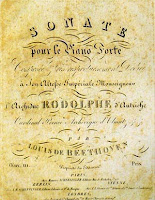On July 31, 1782, Mozart wrote to his father Leopold requesting permission to marry Constanze Weber. But he did not wait for a reply. Four days later the couple married in Vienna's St. Stephen's Cathedral. Mozart was 26 years old. Constanze was 20. Mozart had finally succeeded in making Constanze his wife without Leopold's consent. In a vow of gratitude to fate, Wolfgang undertook to write a mass as an offering to Constanze. The day after the marriage, magically, Leopold's consent arrived.
The Mozart family in Salzburg
From the autumn of 1782 until the middle of 1783 Mozart worked on the score. In January 1873 he wrote to his father telling him that the mass was fifty percent finished. But when the couple visited Leopold in Salzburg, where the Mass had been arranged to be premiered, the work still remained unfinished. With fragments from other masses, it was nonetheless premiered on October 26, 1873, in a parish church (the cathedral was out of the question due to the recent break with Archbishop Colloredo). Constanze sang the soprano soloist parts.
 |
| Constanze Mozart, in 1802 (1762 - 1842) |
As curiously happened with almost all of Mozart's compositions related to Constance, the work remained unfinished forever. The traditional sections of the "common Mass" (as opposed to the Requiem Mass), Mozart would have finished are the Kyrie, Gloria, Sanctus, and Benedictus, leaving the Credo begun and the Agnus Dei unbegun. However, it is also argued that the composer may have finished the work in Salzburg a few days before its premiere, with the originals being lost.
Kyrie
The most frequently appealed section is presented here as a stand-alone piece, the Kyrie, approximately seven minutes long, in a rendition by the City Chamber Orchestra of Hong Kong and choirs, conducted by Helmuth Rilling. Soprano Louise Kwong sings what Constanze sang almost two hundred and fifty years ago.


